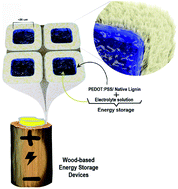Utilizing native lignin as redox-active material in conductive wood for electronic and energy storage applications†
Abstract
Nanostructured wood veneer with added electroactive functionality combines structural and functional properties into eco-friendly, low-cost nanocomposites for electronics and energy technologies. Here, we report novel conducting polymer-impregnated wood veneer electrodes where the native lignin is preserved, but functionalized for redox activity and used as an active component. The resulting electrodes display a well-preserved structure, redox activity, and high conductivity. Wood samples were sodium sulfite-treated under neutral conditions at 165 °C, followed by the tailored distribution of PEDOT:PSS, not previously used for this purpose. The mild sulfite process introduces sulfonic acid groups inside the nanostructured cell wall, facilitating electrostatic interaction on a molecular level between the residual lignin and PEDOT. The electrodes exhibit a conductivity of up to 203 S m−1 and a specific pseudo-capacitance of up to 38 mF cm−2, with a capacitive contribution from PEDOT:PSS and a faradaic component originating from lignin. We also demonstrate an asymmetric wood pseudo-capacitor reaching a specific capacitance of 22.9 mF cm−2 at 1.2 mA cm−2 current density. This new wood composite design and preparation scheme will support the development of wood-based materials for use in electronics and energy storage.



 Please wait while we load your content...
Please wait while we load your content...